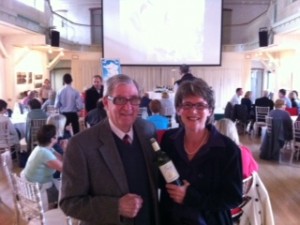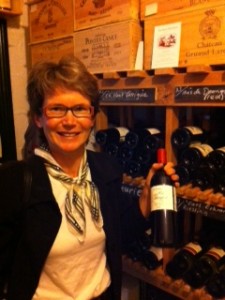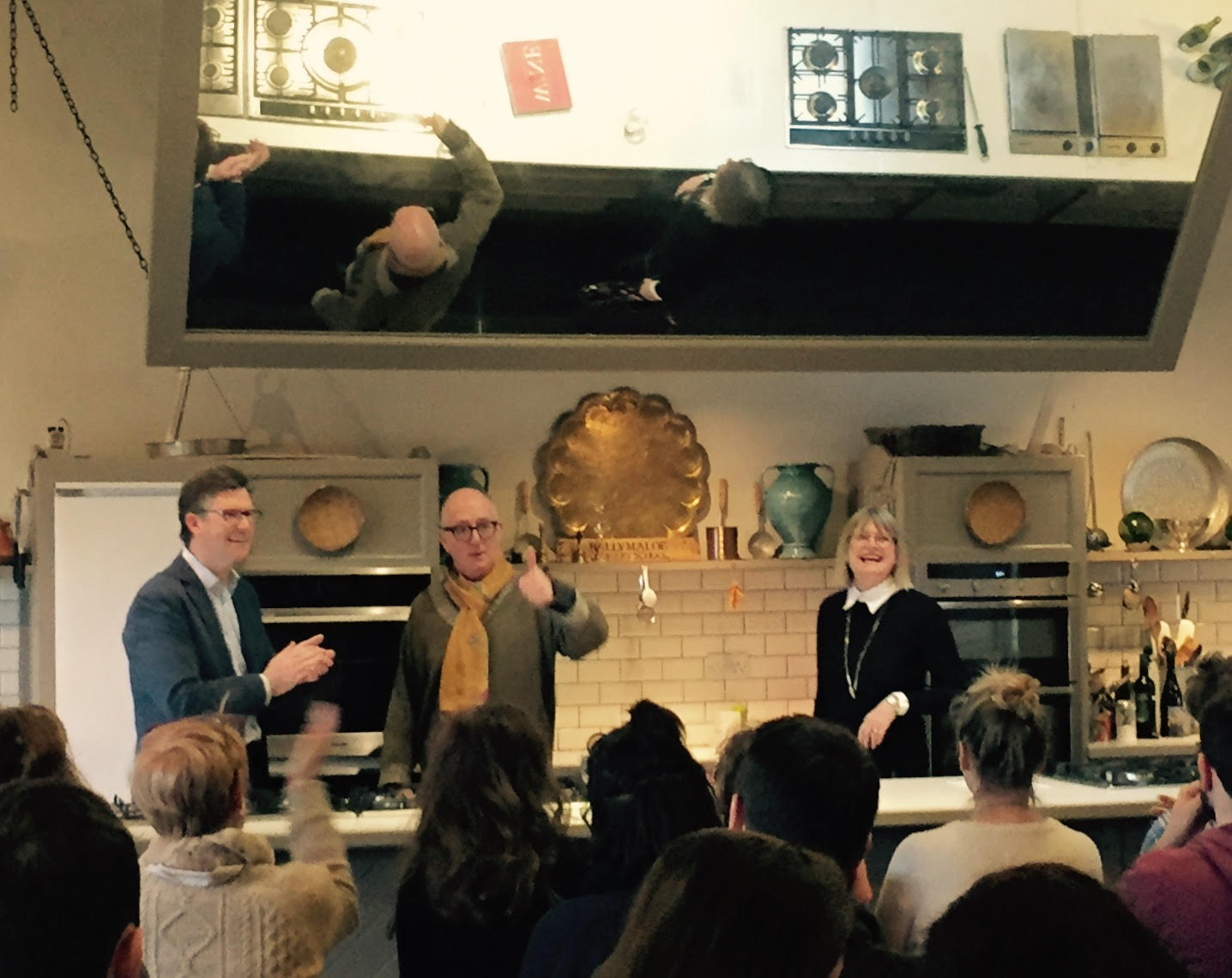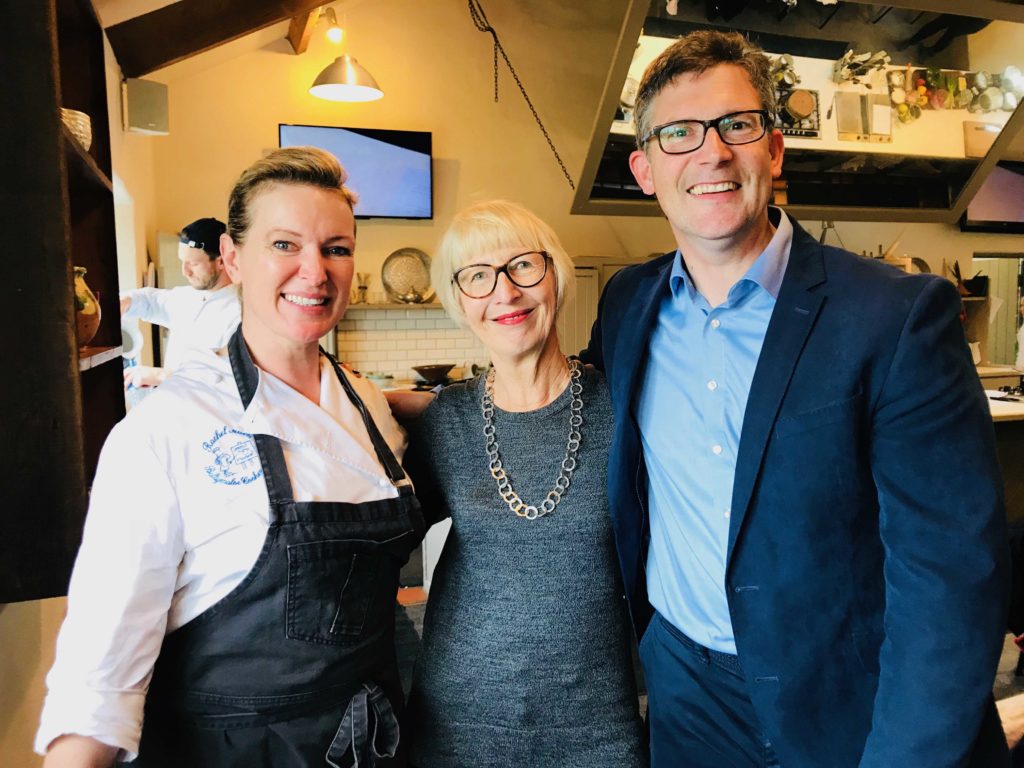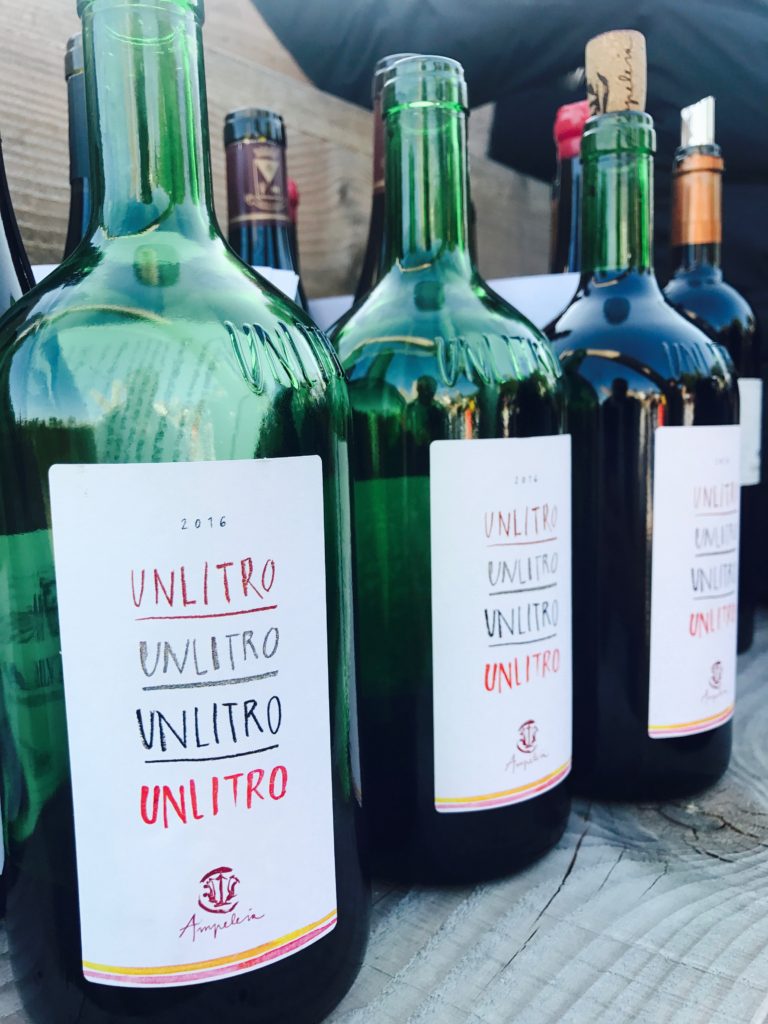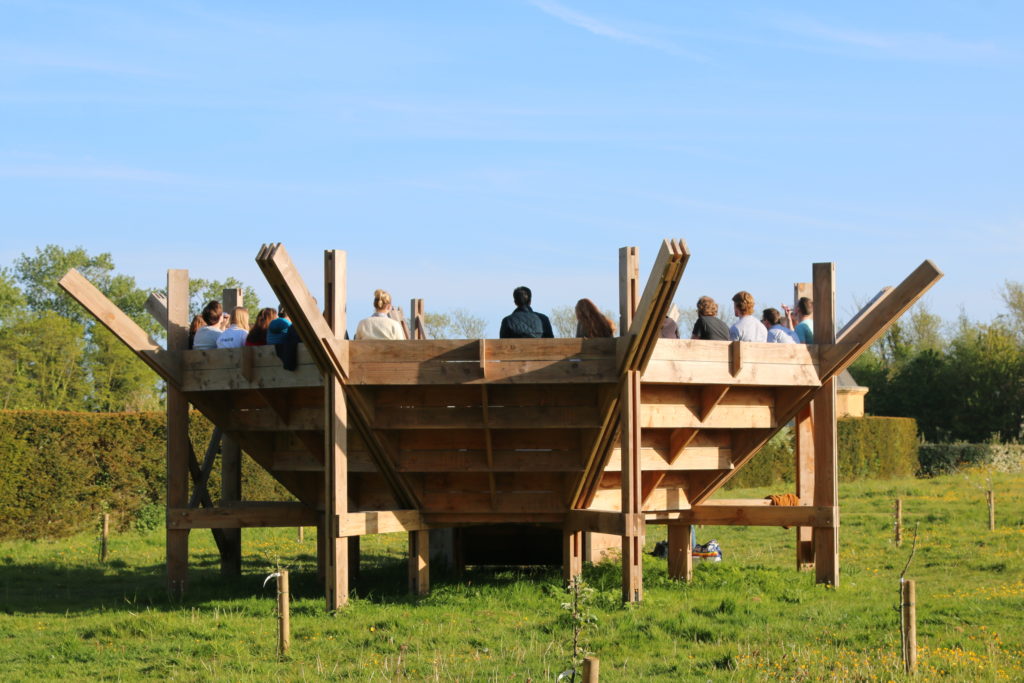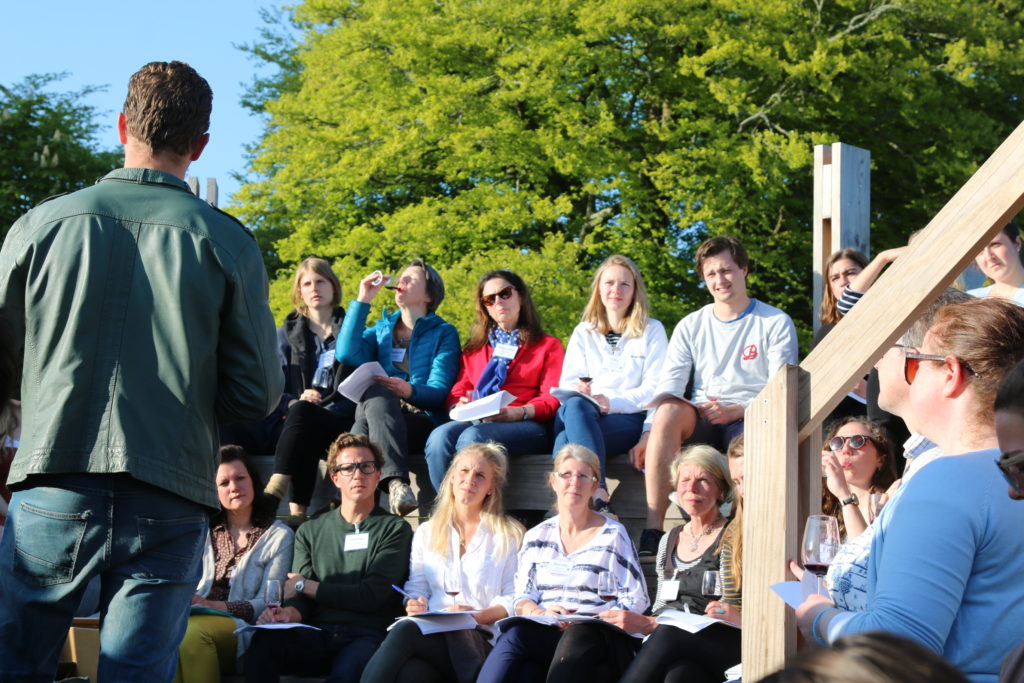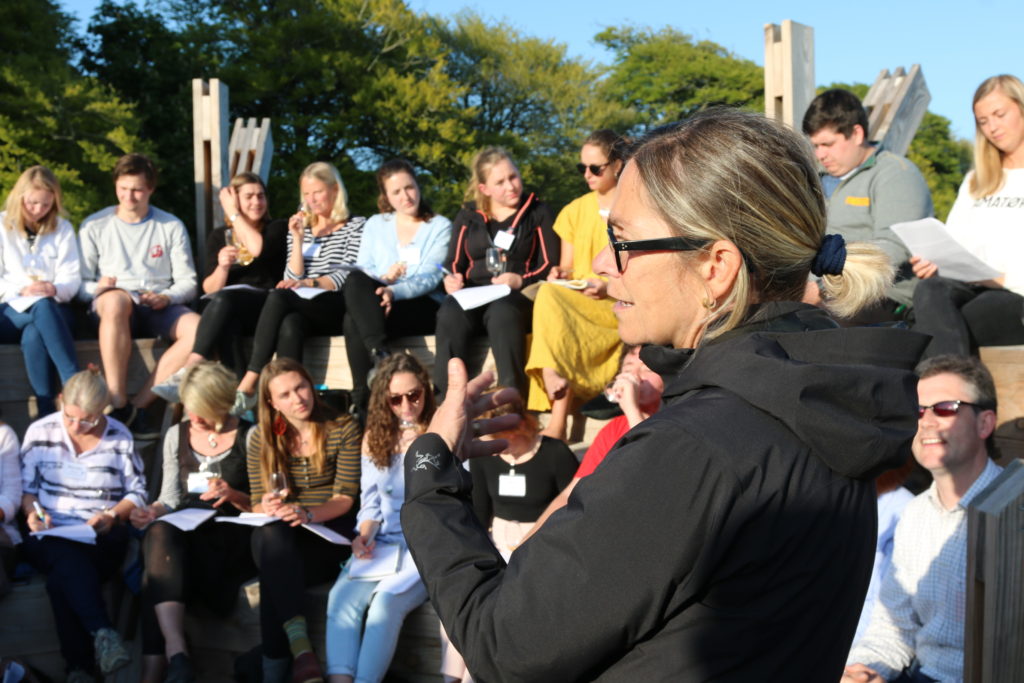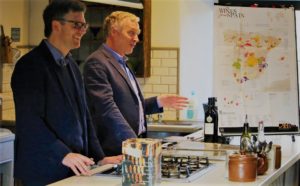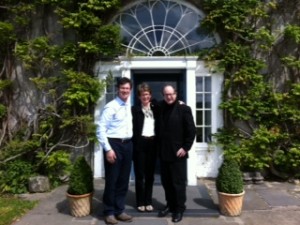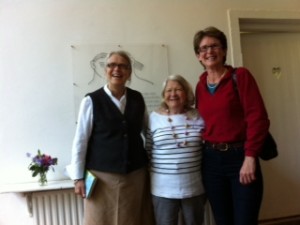Pascal Rossignol of Le Caveau Kilkenny and Jules Verhaeghe of Château du Cèdre, Cahors, South West France provided a fantastic talk & tasting during wine class this week on organic, biodynamic and natural wines to the 12 week certificate cookery course students.
Mary Dowey visit to the Ballymaloe Cookery School
We were delighted to welcome back Mary Dowey, who is one of Ireland’s most experienced wine writers and lecturers to the Cookery School recently. Mary spoke to the 12-week certificate cookery students about her life as a writer, how she started and what continues to inspire her.
“Mary is wine editor of The Gloss since 2006, with a monthly column in the print edition of the magazine and weekly recommendations on thegloss.ie. For the previous decade she was wine correspondent of The Irish Times. She is the only Irish writer to contribute regular articles to the internationally acclaimed British wine magazine Decanter. She has written three books about wine besides contributing to several others.
Mary has run many wine appreciation courses and other events including the highly successful Gloss Wine Dinner Series at Dublin’s Merrion Hotel, now in its tenth year. Enthusiastic about the whole world of wine, she has a particular weakness for finely crafted champagnes and sparkling wines – at any time of dayâ€.
A bunch of winemakers in the garden…
We are delighted to welcome a ‘bunch of winemakers’ to the Ballymaloe Cookery School on Wednesday 10th May, for truly special wine talk and tasting – outside in the garden. Winemakers travelled from wine estates in France and Italy in association with Le Caveau, including Elena Pantaleoni, and Francesca, of La Stoppa, Rivergaro, Emilia-Romagna, Italy; Theo from Foradori in Trentino, Italy; Gulio from Ampelia, Maremma, Tuscany, Italy; Bertrand Ambroise of Maison Ambroise, Premeaux-Prissey, Cotes-de-Nuits, Burgundy, France; Nicolas Donne of Domaine Guy Allion, Touraine, Loire Valley, France; Guilhaume de Conti, of Tour des Gendres, Bergerac, South-West France and Thibaud Chaume of Domaine Chaume-Arnaud, Vinsobres, Rhône Valley, France.
We were fortunate with wonderful May sunshine to be able to have the wine class outside, in the timber amphitheatre in the gardens. A magical evening and our thanks & appreciation to all of the winemakers, who had travelled over, in association with Le Caveau.
Each of the winemakers spoke about their region, their wines and vineyards. All of whom have a focus on low intervention wines, organic, biodynamic and natural viticulture and winemaking. In turn, each of the winemakers gave a tutored tasting of one of their wines by way of illustration (and enjoyable tasting!).
Nicolas Donne of Domaine Guy Allion, Touraine, Loire Valley, France
Cédric and Dorothée Allion run their 30-ha estate with great care and passion. Members of Terra Vitis, their viticultural methods are resolutely organic and sustainable, while minimum intervention during winemaking ensure the wines are pure and offer a true expression of the terroir. The vineyards are mostly planted on slopes overlooking the Cher river, close to the beautiful Chateaux of Chenonceaux and Chambord.
Touraine Sauvignon, Loire Valley 2016
Grape variety: Sauvignon Blanc
Sauvignon character with a real mineral edge, the palate is full-flavoured with freshly squeezed lemon mingling with white fruit, pear and green apples ending with racy, fresh notes.
“This wine is produced under the Terra Vitis ethic that it is an approach based on reason, not faith. Cédric and Dorothée Allion`s small estate minimises strategic intervention in the vineyard and studiously avoids chemical additives. The results speak for themselves here – this is a super smart sauvignon blanc that is crisp to the point of steely sharpness, bursting with gooseberry, peanut and nettle notes. A clear and startlingly well priced competitor to New World sauvignon†Tomas Clancy, Sunday Business Post
Gulio of Ampelia, Maremma, Tuscany, Italy
Ampeleia (from the Greek word for ‘vine’) is owned by Elisabetta Foradori and Giovani Podini. It was founded with Elisabetta’s overarching vision of allowing the true nature of an area, its diversity, its grapes, land and culture to be expressed. The wildness of the southern Maremma, bounded by the Colle Metallifere and the sea were virgin territory, far removed from the glamour of Bolgheri and Montalcino. The estate is interspersed with chestnut and cork oak forests as well as Mediterranean scrub.Â
‘Un Litro’, by Ampelia, Maremma, Tuscany, Italy 2016
Grape varieties: Alicante (Grenache), Carignan and Alicante Bousche
‘Un Litro’ is a true expression of the wild Mediterranean terroir of the Maremma. It is a peasant wine in the best sense of the word: a joyous, infinitely drinkable blend of Alicante (Grenache), Carignan and Alicante Bouschet which grow so well in this hot, southerly corner of Tuscany. It spends 6 months in cement tanks. Unfined, unfiltered, no added SO2. (Total SO2: 41 mg/l) Balsamic character on the nose, wild herbs and spices hints. Well defined on the palate, clear-cut and neat. Contrasting finish with pleasantly bitter notes of cherries and wild strawberries.
Bertrand Ambroise of Maison Ambroise, Premeaux-Prissey, Cotes-de-Nuits, Burgundy, France
Bertrand Ambroise, and his son Francois and daughter Ludivine operate on 21 hectares and purchase grapes from another 3. Their vineyards were converted to organic viticulture and they received their certification in 2013. From manually harvested grapes, neither filtered nor fined, the wines are classic Burgundy with distinct terroir-influenced personalities.Â
Cotes de Nuits Villages, by Maison Ambroise, Burgundy 2015
Grape variety: Pinot Noir
Cotes de Nuits Villages is beautifully expressive and lush, with ripe red fruits, earth and a touch of creamy oak. It is dry and medium bodied, perfect balanced, with ripe juicy fruit. Oak on back palate with will further soften with age. Long finish.
Theo of Foradori, Trentino, Italy
The mountain ranges that make up the Dolomites, a World Heritage Site, are found between the Veneto, Trentino-Alto Adige and Friuli-Venezia Giulia regions and delineate a landscape of extraordinary beauty. Elisabetta Foradori’s grandfather bought the estate, based in Mezzolombardo, in 1929, a mere ten years after Italy’s annexation of the province from the defunct Austro-Hungarian empire meant that the traditional markets for the local wines had disappeared. At first, the wine was sold to local co-operatives, but Elisabetta’s father began bottle and sell their own production. His life was cut tragically short by cancer when Elisabetta was just eleven years old. Nine years later, she had graduated in viticulture and oenology and had taken over the reigns of the estate, albeit more out of a sense of duty than passion. Teroldego from the Rotaliano plain had been singled out for its quality since at least the 14th century, but the prevailing philosophy, post-WW2, was to squeeze maximum yields through clonal selection and an industrial approach to production. She decided to dedicate her work to renewing Teroldego and planted as many cuttings as she could.Â
Teroldego plunges its roots deep into the limestone, granitic and porphyritic rocks of the Campo Rotaliano, a small plain embedded between steep rock faces in Trentino (Northern Italy). It is the intense expression of its land, of its people, of the Dolomites. By 2002, Foradori had garnered international recognition for her work and visionary approach. However, always changing and evolving, she decided to convert the estate to biodynamic viticulture. Seeing the change in the quality and drinkability of her wines, she applied for and received organic and biodynamic certification in 2009. The vineyards cover 28 hectares – 75% of Teroldego, 15% of Manzoni Bianco, 5% of Nosiola and 5% of Pinot Grigio
Foradori ‘Morei’, Trentino, Italy 2015
Grape variety: Teroldego
‘Morei’ again from local dialect, translates as ‘moro’/’scuro’. The Teroldego here plunges its roots deep in the stones and sand of the soil carried by the river Noce giving rise to deeply coloured wines with a dense and mineral texture. Eight months on the skins in clay amphorae
‘Morei is very fresh, pure and linear with pure red cherry fruit and lovely fine-grained structure. Elegant, direct and pure.’ Wine writer, Jamie Goode
Guilhaume de Conti, of Tour des Gendres, Bergerac, South-West France 2014
Viticulture is biodynamic, the soil is nourished with seaweed and silica treatments to encourage microbial activity. Yields are low, 5 to 6 bunches per vine, manual picking and selection of ripe and healthy grapes is essential; on the top cuvées there are several ‘tries’ in the vineyard, and the wine will only be released if it reaches the highest of standards. The blends will also change according to the physiological ripeness of the grapes
Gloire de Mon Pere, Chateau Tour des Gendres, Bergerac, South-West France
Grape varieties: Merlot, Cabernet Sauvignon, Malbec, and Cabernet Franc.
Gloire de mon Père – The nose is intense and powerful – black fruit, dark chocolate, anisee with flowery notes. Generous and ripe on the palate, the layers of sweet, juicy fruit are supported by a firm but balanced tannic structure.
Thibaud Chaume, of Domaine Chaume-Arnaud, Rhône Valley, France
Domaine Chaume-Arnaud biodynamic vineyards are planted on slopes and terraces around the picturesque villages of Vinsobres and Saint-Maurice, near Nyons. The altitude, between 200 to 450m, and the cool wind from the nearby Alps (the Pontias) keep the temperature lower than the neighbouring villages and contribute to the natural freshness and complexity of the wines. Harvest in done by hand and yields are kept very low. Â
The Chaume-Arnaud Côtes du Rhone is a blend of Grenache, Syrah and Cinsault, dark-coloured, it has a rich and velvety character. Very inviting nose, sweetly fruited, with gamey/meaty hints. Gorgeously ripe and juicy cherry, plum and cream on the palate with discreet spices. Fine tannins and acidity on the finish hold and balance this brilliant wine very well.
Elena Pantaleoni of La Stoppa, Rivergaro, Emilia-Romagna, Italy
La Stoppa is located in the Colli Piacentini in north-west EmiliaRomagna. Founded in the late 19th century by Gian-Marco Ageno, the estate was bought by Elena Pantaleoni’s father in 1973. At the time, the estate focused on producing international style wines. Elena inherited the estate in 1991 and by 1996, she and head vignaiolo Giulio Armani began to execute the vision they had for the future of the estate. They replanted Barbera and Bornada, as well as a small amount of Malvasia Candia, Ortrugo and Trebianno, all of which were much more suited to the hot climate and heavy clay soils of the Colli Piacentini.Â
The vines were worked organically from the early 90s and La Stoppa received organic certification in 2008. Elena, in typical humble fashion, describes herself as ‘la custode de la vigne’, merely a guardian, until she in her turn passes the estate to the next generation. Her low-key, but powerful conviction is that her responsibility is to farm and make wine in as sustainable, non-interventionist and authentic a way as possible. The wines qualify for Colli Piacentini DOC, but are bottled as Emilia IGT because she feels that the rules of the DOC do not allow the authenticity of the terroir to speak. Her stances on the necessity of truly artisan (as opposed to industrial) production, the use of indigenous grape varieties, yeasts and minimal intervention in the cantina have made her a leading voice for devotees of natural, artisanal wine. She featured in Jonathon Nossiter’s 2015 documentary ‘Natural Resistance’.Â
La Stoppa ‘Malvasia Dolce Frizzante’, Emilia-Romagna, Italy 2015
Malvasia Dolce Frizzante, is luscious and subtely sweet with a soft sparkle, the wine is made from Malvasia di Candia grape variety. Single fermentation via the Charmat Method. Honeyed on the palate with floral, tangy fruits. Light, frothy, off-dry. White peach, lightly floral, simple, but delicious purity. Ideal as an aperitif, although Italians would drink this more as a light dessert wine with fruit desserts. It is a ‘mosto parzialemente fermentato’ wine. The method is to pick the aromatic Malvasia grapes quickly and do a very gentle pressing. The juice or ‘mosto’ partially fermented with the fermentation stopped by reducing the temperature. This results in a low alcohol, semi-sparkling, gently sweet wine.
Italian natural wine star
  Elena Pantaleoni and Nicholas Sciackitano of La Stoppa, and Pascal Rossignol of Le Caveau, with Darina from April 2016, during Elena’s visit to the school.
 Elena Pantaleoni and Nicholas Sciackitano of La Stoppa, and Pascal Rossignol of Le Caveau, with Darina from April 2016, during Elena’s visit to the school.
We are joined recently in one of our wine classes, via Skype, by Elena Pantaleoni of La Stoppa.
La Stoppa is located in Emilia Romagna and the estate is run by Elena Pantaleoni, along with Giulio Armani, who both starred in the natural wine film ‘Natural Resistance’.

La Stoppa is a wonderful organically-tended estate surrounded by Elena’s home, a 14th century castle, where wild herbs grow freely between the rows of vines and no chemical fertilizers, weed killers or pesticides are ever applied.
Elena spoke to the students about growing and making wine naturally. She gave a tutored tasting of the following wines, via Skype, to the 12-week certificate cookery school students:
La Stoppa Trebbiolo Rosso, Emilia-Romagna, Italy
Grape varieties: Barbera and Bonarda
Trebbiolo Rosso is a natural wine made from the Barbera and Bonarda grape varieties. The nose is fresh with cherry and red berries mingling with wilder notes. Lively and juicy, the palate bursts with sweet/sour morello cherries and hints of spices. In all, it is a lovely, fresh, lively and fruit-driven wine which is best enjoyed with food.



La Stoppa Ageno, Emilia-Romagna, Italy
Grape varieties: 60% Malvasia di Candia Aromatica, 40% Ortrugo and Trebbiano
This is an ‘orange wine (orange / amber / skin contact wines, are white wines that are made like a red, i.e. with grape skin contact)
Ageno is made from 60% Malvasia di Candia Aromatica, 40% Ortrugo and Trebbiano grown on clay/limestone soils in a very warm climate (Elena says that this part of Emilia can be hotter than Sicily during the summer). The juice and skins stay in contact for 30 days and fermentation takes place spontaneously with ambient yeasts. The resulting wine is matured for 12 months, half in stainless steel, the other half in used French oak barriques, with a further 2 years in bottle before release.
“Deep golden/amber in colour. On first pouring, bruised apple. With air, it becomes incredibly complex: candied orange peel and grapefruit, honey, smoke, nuts, and a herbal and Mediterranean character. The palate is medium full, bone dry, again very complex and intriguing. Candied fruit flavours on the sweeter end, yet somehow also savoury, nutty, umami characteristics. Very well balanced, with linear, mouthwatering acidity, a touch of palate-cleansing astringency and a lengthy finishâ€


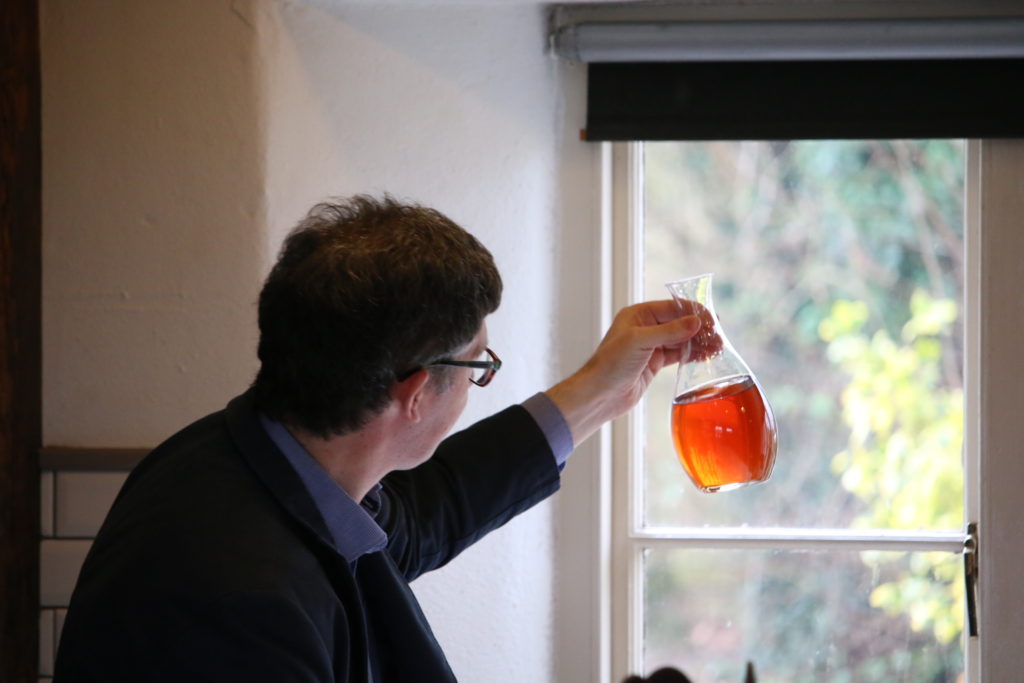
La Stoppa Malvasia Dolce Frizzante, Emilia-Romagna, Italy
Grape variety: Malvasia di Candia Aromatica.
100% Malvasia di Candia Aromatica. After a soft pressing in a horizontal press, the wine is fermented using indigenous yeasts in a closed, pressurized tank. The result is a lightly sparkling, semi-sweet wine with only 7% alcohol.
Malvasia Dolce Frizzante, is luscious and subtly sweet with a soft sparkle, the wine is made from the Malvasia di Candia grape variety. Peach, apple, floral, honeyed on the palate with floral, tangy fruits. Delicious with fruit desserts – or on its own!
Our thanks to Elena for an inspiring talk to the students. Further information on La Stoppa on their the website www.lastoppa.it


Following on from this we continued the wine class along the theme of organic, biodynamic and natural wines and we were delighted to be joined by Pascal Rossignol of Le Caveau (McKenna Guides Wine Person of the Year 2017). Pascal has been a guest wine lecturer at Ballymaloe Cookery School since 2006 and our thanks once again to Pascal for a fantastic class, and a tutored tasting of the following wines:

Meyer-Fonne Riesling ‘Katzenthal’, Alsace, France
For centuries, Alsace, the frontier province in northeastern France just across the Rhine from Germany, had been passed back and forth between the French and the Germans, depending on who had won the last battle. Felix Meyer has built a solid reputation in Alsace. Working extremely hard in the vineyard, keeping yields ridiculously low, the immense quality of the granitic soils of Katzenthal is reflected in every single of Felix wines. No other grower in the area produces wines with such precision, purity and expression of terroir. Riesling Katzenthal, grown on the granitic slopes surrounding the village is a very distinguished and racy wine. Pure, mineral nose with hints of citrus and ginger. Rich, ample and ripe on the palate with nectarine, orange peel and peachy character the lead to the finish is pristine and impeccably balanced by good acidity


Terre di Pietra, Valpolicella ‘Vigna del Peste’, Veneto, Italy
This farm is owned by Laura Albertini and family and situated in Marcellise in the hills east of Verona. Terre di Pietra is a reference to the particular varieties of stony soils. These vineyards of Corvina, Corvinone, Rondinella and Molinara are over 40 years. Farming is organic – they started official conversion in 2011. All the work in the winery is done manually with respect for the grape variety and the terroir. Laura designs label composed of various bands of colour to denote the different types of rock which compose the subsoil underneath the vineyards. Red fruits such as cherries and juicy red plums with a hint of bitterness. The minerality of the estate’s limestone soil is evident in this wine and the finish tasty and fresh.

Familia Ceechin Malbec Mendoza, Argentina
Located in Russell – Maipu, this 75-ha organic farm is owned and run by the Cecchin family since 1959. Strict adherence to organic methods in the vineyard, limited yields and minimal interventions in the winery result in very articulate wines that truly reflect their terroir and capture the essence of the fruit.
The Malbec, a grape that Argentina has successfully appropriated, is made without the addition of sulphites. The nose opens up with enticing, ripe plum, bruised red cherries, liquorice, dark chocolate and a delicate earthiness. These lovely fruit and seeds are also found on the ripe, well-balanced palate and the natural acidity hold this eminently drinkable wine perfectly.
Our thanks to Pascal Rossignol for another fantastic class to the students.
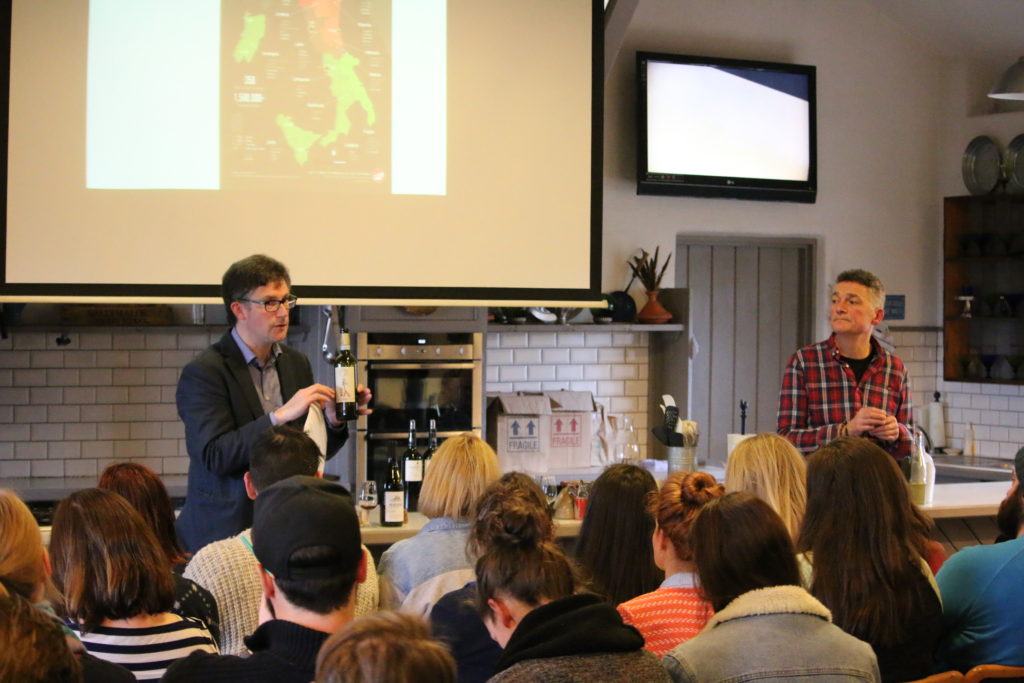
Spanish Sunshine in Shanagarry with John Wilson
On a lovely spring morning, John Wilson brought some Spanish sunshine to the 12-week certificate students here at the cookery school in Shanagarry. John Wilson, one of Ireland best known wine writers, and wine correspondent to The Irish Times, introduced the students to the wine regions and wines of Spain, while also incorporating Spanish food, heritage and culture into the morning’s masterclass on Wines of Spain.
John gave a tutored tasting of the following wines:
Louro de Bolo 2015 Valdeorras, Rafael Palacios
La Iña Fino Lustau, Jerez
La Malkerida 2014 Utiel-Requena
Flor de Brezo Gregory Perez, Bierzo
La Bruja de Rozas 2015, Viños de Madrid, Sierra de Gredos, Commando G.
Rioja Reserva 2012, Marques de Murrieta
Ribera del Duero Cosecha 2014, Emilio Moro
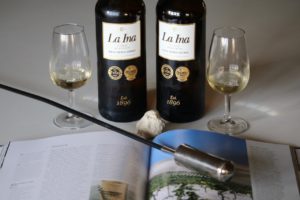
John Wilson is the Irish Times wine correspondent, John Wilson http://www.irishtimes.com/life-and-style/food-and-drink/drink/the-white-wines-of-galicia-1.2814683 and has 20 years of practical experience in the wine trade under his belt. He is author of ‘Wilson on Wine 2015, 2016 and 2017 edition. His other wine writing including editing ‘The Wine Guide’, Ireland’s best ever selling wine book. Most of all, as he says himself, he likes a glass of decent wine. You can follow John on twitter at @wilsononwine and on his blog www.wilsononwine.ie
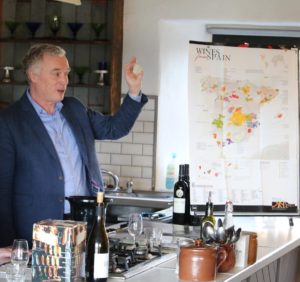
The Wines of Spain masterclass by John Wilson to the 12 week certificate cookery students at Ballymaloe Cookery School was fantastic – the students really appreciated it and they felt like they were in Spain itself, learning all about Spanish wines and regions and also the food, places and people.
The Spanish wines showed very well under the East Cork sunshine!

Welcome back Alice!
We were delighted to recently have the opportunity to introduce New York based wine writer Alice Feiring to the 12 week cookery students, virtually –via Skype. We beamed Alice onto the big screen in the demo room live from New York for a very interactive talk and Q&A with the students.
Alice Feiring (who presented fantastic talks and tastings at Litfest’15 here at Ballymaloe) is an internationally known author and journalist who lives in New York and leads an international debate on wine made naturally. She has been the wine correspondent for Wall Street Journal Magazine and Time Magazine and now freelances for publications including the New York Times. Alice is a winner of both the James Beard and the Louis Roederer wine writing awards.

Alice gave an inspiring talk to the cookery school students about natural wine. By way of illustration during the talk, we showed Vino di Anno, a natural wine from Mt Etna, Sicily, made by Anna Martens & Eric Narioo in a Qvevri (Qvevri in Georgia were one of the first vessels ever to be used for wine fermentation, terracotta vessels, buried completely surrounded by the natural coolness of the earth, with just the top part barely above ground)
Alice also spoke about Georgian wine and Georgia in general, a subject near and dear to Alice’s heart and the subject of one of her books ‘For the Love of Wine, my odyssey through the world’s most ancient wine culture’, published March 2016, about the people, places, food, and natural wines of Georgia.
She is author of several books, including The Battle for Wine and Love: Or How I Saved the World From Parkerization and Naked Wine: Letting Grapes Do What Comes Naturally. Translations of her books have been published in French, Spanish, Italian and Georgian. In 2012 she launched The Feiring Line, the only subscription-based natural wine newsletter where you can ke ep up to date on Alice’s writing www.alicefeiring.com/newsletter
On Twitter: @alicefeiring
Our heartfelt thanks to Alice for her time and a wonderful talk which we and the students so very much appreciated.
Upcoming wine events at Ballymaloe 2013
2013 is already looking like a good vintage Рfor wine events at Ballymaloe. We are looking forward to great line-up of wine events, and to welcoming Jean-Charles Cazes of Ch̢teau Lynch-Bages, on March 10th, and to welcoming back Jancis Robinson MW in May 2013 as part of the Ballymaloe Literary Festival of Food and Wine.
Jean-Charles Cazes
Château Lynch-Bages, needs no introduction in Ireland – one of the best known, respected, collected and followed, of the ‘Irish Wine Geese’ Château of Bordeaux. We are delighted to be welcoming Jean Charles to Ballymaloe – and as part of The Gathering 2013, there will also be a series of other wine events, which are being planned for Cork City and County, throughout the year, with ‘Irish Wine Geese’ winemakers from all over the wine world, ‘flying home’.
Born in Bordeaux, Jean-Charles Cazes grew up in Pauillac in the heart of the family vineyards at Château Lynch Bages, and since 2006, taking over from his father, Jean-Michel Cazes, he has been in charge of all the family vineyards, in France and abroad. Join Jean Charles at Ballymaloe, for one, or both, of the following events – a wine tasting & presentation in the Grain Store at Ballymaloe, followed by a wine dinner, with the wines of Château Lynch Bages and The Cazes Family Collection wines. Wine tasting & presentation, by Jean Charles Cazes, at The Grain Store, Ballymaloe, 6.30pm, Sunday 10th March €18. Followed by a wine dinner, with Jean Charles Cazes, in the Yeats Room dining room, at Ballymaloe House 8.30pm €95. Advance booking advised. Special rates also available for accommodation
Jancis Robinson MW
One of a handful of wine communicators with an international reputation, Jancis Robinson writes daily for JancisRobinson.com (voted first-ever Wine Website of the Year in the Louis Roederer International Wine Writers Awards2010), weekly for The Financial Times, and bi-monthly for a column that is syndicated around the world. She is also editor of The Oxford Companion to Wine, co-author with Hugh Johnson of The World Atlas of Wine, co-author of Wine Grapes – A complete guide to 1,368 vine varieties, including their origins and flavours, each of these books recognised as a standard reference worldwide.
An award-winning TV presenter, she is invited all over the world to conduct wine events and act as a wine judge. In 1984 she was the first person outside the wine trade to pass the rigorous Master of Wine exams and in 2003 she was awarded an OBE by Her Majesty the Queen, on whose cellar she now advises.
She loves and lives for wine in all its glorious diversity, generally favouring balance and subtlety over sheer mass.
We are delighted to be welcoming Jancis & Nick back to Ballymaloe, and looking forward to the Ballymaloe Literary Festival of Food and Wine
Ballymaloe awarded ‘Best Restaurant Wine List and Wine Service’ (nationwide)
We were all delighted in Ballymaloe to be recently awarded ‘Best restaurant wine list and wine service (nationwide)’ by Tomás Clancy in his annual Sunday Business Post wine awards, published 6th January, 2013.
We were also delighted that our pop-up wine shop at Ballymaloe featured in the Top 5 ‘Best new wine merchants’.
Our congratulations to all listed and to Ireland’s vibrant wine community.
Irish Wine Geese
Caro Feely, author of ‘Grape Expectations’, and owner & winemaker at Irish owned & Irish run, biodynamic Chateau Haut Garrigue, Bergerac, South-West France, and Tomas Clancy, well known wine writer, recently gave a co-presentation at Ballymaloe on The Irish Wine Geese – Irish people both long ago, and present day, who are involved in winemaking around the world. A fascinating insight into generation of Irish people in all corners of the wine world, with a great selection of wines to taste as well. We also served ‘Irish Wine Geese’ wines at another recent event in Ballymaloe
